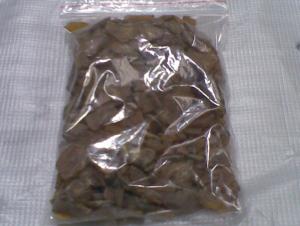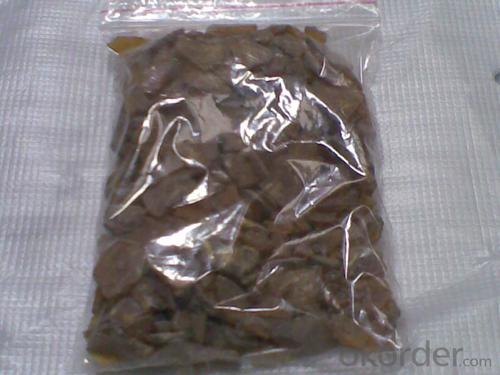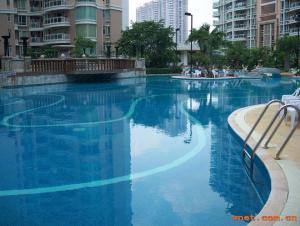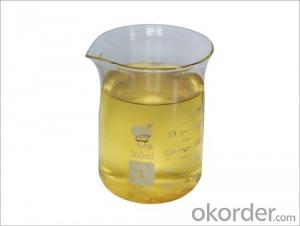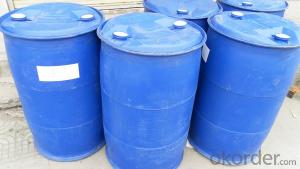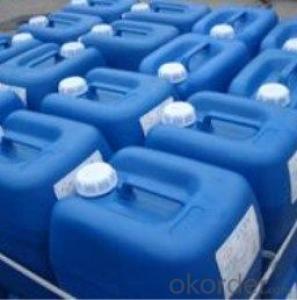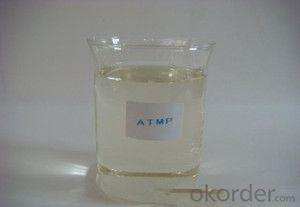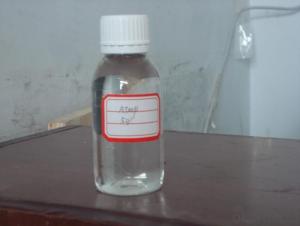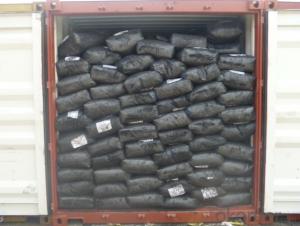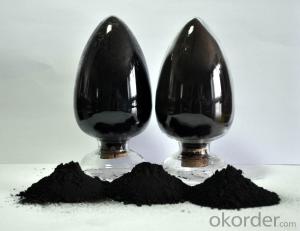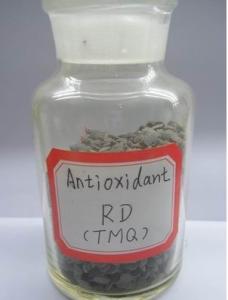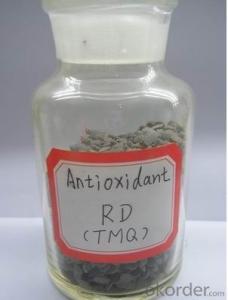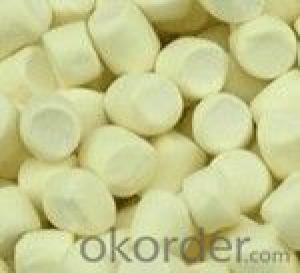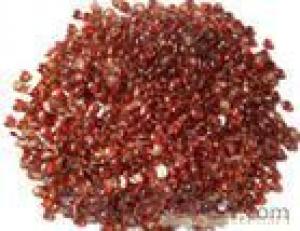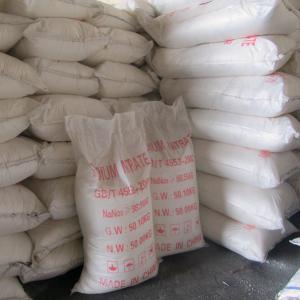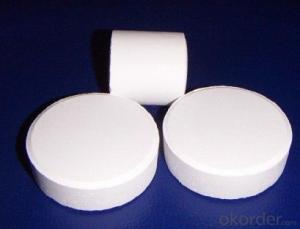Rubber Antioxidant RD (TMQ)
- Loading Port:
- China Main Port
- Payment Terms:
- TT or LC
- Min Order Qty:
- 1 Metric Ton m.t.
- Supply Capability:
- -
OKorder Service Pledge
OKorder Financial Service
You Might Also Like
1, RD (TMQ)
Chemical Name:2,2,24-Trimethy 1-1,2- Dihydroquinoline content
Molecular Weight: (173.26)n
CAS No.:26780-96-1
Executive standard: GB/T 8826-2003
Specification:
|
Item |
Index | ||
|
High Content |
High Class Product |
First Class Product | |
|
Appearance |
Amber to light brown flake or granular | ||
|
Softening Point ℃ |
90.0+10.0 |
80~100 | |
|
Heat Loss % ≤ |
0.30 |
0.30 |
0.50 |
|
Ash% ≤ |
0.20 |
0.30 |
0.50 |
|
Assay % ≥ |
77.0 |
-- |
-- |
|
Isopropyl-bis aniline % ≤ |
0.20 |
-- |
-- |
|
Issolubles in alcohol % ≤ |
0.50 |
-- |
-- |
Properties: Pale yellow to amber power or thin.Nontoxic Not soluble in water, soluble in benzene.Chloroform,acetone and carbon disulfide,Miro-soluble petroleum hydrocarbons.
Application:The product is particular excellent kinds od eneral-purpose ammonia anti-ageing agent.Ti particular suit to full-stell,semi-steel radial tire and it apply to many kinds of the tires,rubber tube,gummed tape, rubber overshoes and general industrial rubber producers and also suits to emulsion products.
Packing:25kg paper bag inner with PE bag.
Storage:The product should be stored in the fry and colling place with good ventilation. The product should be avoid hot sunshine.
- Q: Chemical production of iodine and magnesium with water as catalyst!
- In the 250mL three bottles were equipped with spherical condenser and constant pressure dropping funnel, in the condensate tube connected to the anhydrous calcium chloride drying tube. The flask was placed with 1.5 g of magnesium chip and a small tablet of iodine, 10 g of bromobenzene and 30 mL of anhydrous ether were mixed in a constant pressure dropping funnel. First 1/4 of the mixture into the flask, a few minutes later see the magnesium surface of the bubble generated, the solution was slightly cloudy, iodine color began to disappear. If no reaction occurs, use a hot water bath. After the start of the reaction, stir, slowly dropping the remaining bromophene ether solution, dropping the rate to keep the solution was slightly boiling state, after adding, in the water bath to continue reflow 0.5h, magnesium tablets full effect.
- Q: Hydrogen and oxygen in the role of the catalyst can do the chemical formula of aviation fuel?
- You two yeah? Meaning that hydrogen is ignited in oxygen to release energy to push the rocket forward, as the catalyst for those who love,
- Q: Seems intuitive that it wouldn't, but I dunno the qualitative difference between activation energy & Gibbs free energy. I'M TOO LAZY TO GOOGLE I GOTS STUFF TO DO
- A catalyst can change the activation energy not the Gibbs energy. The Gibbs energy is the energy difference between the initial state and final state. A catalyst cannot change that. Imagine you are driving from school to home. How you drive do not change the height difference between the school and your home. However, a catalyst can change your path which can change the routine you drive from school to home. So if there is a hill in between your school and you home, you have the choice to drive through it or drive around. Here is a picture: upload.wikimedia.org/wikipedia/co... A catalyst can change the height of the barrier, but cannot alter the initial or final state.
- Q: What is the nature of the chemical catalyst?
- Different reactions have different catalysts, mainly catalyzed, to speed up the reaction rate
- Q: I think doubling the concentration of catalyst will double the rate of a reaction (K2/K1 =2). I want to confirm. This is for my project work. Please reply as soon as possible.
- A catalyst speeds up a chemical reaction by providing an alternate reaction pathway with a lower activation energy, thus increasing the number of collisions that can result in the formation of product. When the catalyst is a reactant in the rate determining step, and the reaction is first order in the catalyst, then a doubling of the concentration will double the rate. But if the rate determining step which includes the catalyst is not first order, then doubling the concentration won't double the rate. Then there is the case of a heterogeneous catalyst in which the reaction is essentially zero order in the catalyst. The amount of catalyst won't affect the speed of the reaction beyond the initial increase. The mere fact that the catalyst is present speeds up the reaction.
- Q: Is palladium predominantly a catalyst in chemistry?
- Palladium in the chemical mainly to do the catalyst; palladium and ruthenium, iridium, silver, gold, copper and other alloy, can improve the palladium resistivity, hardness and strength, used in the manufacture of precision resistors, jewelry and so on.
- Q: What is the difference between biological and chemical catalysts?
- Biological catalyst: 1. Biological catalysts or enzymes are high molecular weight globular proteins. 2.Their composition may change at the end of reaction. 3.Their catalyzing effect is very high. i.e faster than chemical catalyst. 4.They are reaction specific. i.e One enzyme or biological catalyst may catalyze only particular type of reaction and not many. 5.They are intolerant to temperature and pH changes. An enzyme can not function outside its temperature or pH range. e.g amylase,lipase,pepsin Chemical catalyst: 1.Chemical catalysts are simple inorganic molecules with low molecular weight. 2.They remain unchanged at the end of reaction. 3.They are slower compared to enzymes. 4.They are not reaction specific. 5.They function within wide range of temperatures,pH or pressure. e.g vanadium dioxide, platinum
- Q: Just something I've always wondered about...
- there are so much catalysts made up of transition metals. because one of the characteristics of transition metals is can be made to catalyst. one of the catalyst that is mostly used is iron fillings which is used as catalyst to make ammonia from nitrogen gas and hydrogen gas.
- Q: Now, i am studying for my biology exam in 3 weeks time...i stumbled upon catalase, and then checked my book its catalyst...now im confused...is there a different among these 2 terms? i think..catalyst is the when a substance brings up or about a chemical reaction without using itself up and then catalase breaks down the toxic by-product of metabolism, hydrogen peroxide, into water and oxygen.Or am i wrong?please explain what is catalyst and catalase in biology or are they the same, just differently?
- an enzyme that decomposes hydrogen peroxide into oxygen and water.a substance that causes or accelerates a chemical reaction without itself being affected. To put thing simply, a catalyst is any substance that speeds up a chemical reaction. These can be natural or manmade. Catalase is actually a specific type of naturally-occuring catalyst, an enzyme in cells that decomposes hydrogen peroxide (Which is extremely toxic to life!) into harmless components. Catalase enzymes are highly concentrated in the aptly named cell organelles known as peroxisomes. Just remember- if the word ends in -ase, it's a type of enzyme! :) Hope this information helps!
- Q: What kind of compounds or elements can be used as catalysts in high school chemistry? What is the catalyst for what?
- High school is the most common is manganese dioxide, and potassium permanganate heating oxygen, hydrogen peroxide decomposition are used, which is inferred in the problem there is a lot of
1. Manufacturer Overview
| Location | Shandong, China |
| Year Established | 2004 |
| Annual Output Value | Above US$ 10 Million |
| Main Markets | North America; South America; Eastern Europe; Southeast Asia |
| Company Certifications | ISO 9001:2000 |
2. Manufacturer Certificates
| a) Certification Name | |
| Range | |
| Reference | |
| Validity Period |
3. Manufacturer Capability
| a) Trade Capacity | |
| Nearest Port | Qingdao Port |
| Export Percentage | 41% - 50% |
| No.of Employees in Trade Department | Above 10 People |
| Language Spoken: | English; Chinese; |
| b) Factory Information | |
| Factory Size: | Above 13,000 square meters |
| No. of Production Lines | Above 2 |
| Contract Manufacturing | Design Service Offered; Buyer Label Offered |
| Product Price Range | High; Average |
Send your message to us
Rubber Antioxidant RD (TMQ)
- Loading Port:
- China Main Port
- Payment Terms:
- TT or LC
- Min Order Qty:
- 1 Metric Ton m.t.
- Supply Capability:
- -
OKorder Service Pledge
OKorder Financial Service
Similar products
Hot products
Hot Searches
